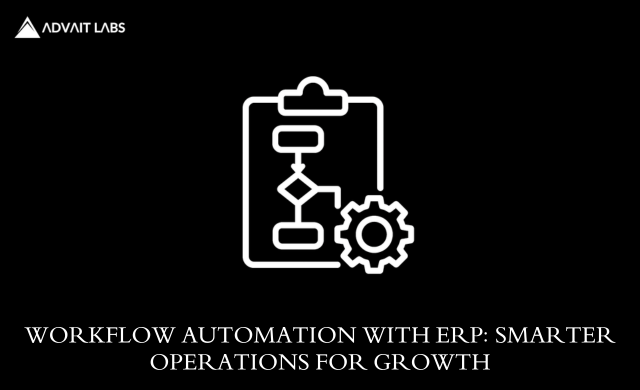Workflow Automation with ERP: Step-by-Step

In today’s fast-paced business world, workflow automation has become more than a buzzword—it’s a necessity for growth and efficiency. Companies are constantly seeking ways to reduce manual effort, eliminate bottlenecks, and improve operational visibility. That’s where ERP (Enterprise Resource Planning) systems come in.
At Advait Labs, a Hyderabad-based technology company specializing in ERP integrations, we’ve helped organizations of all sizes streamline their business processes through workflow automation. In this article, we’ll walk you through a step-by-step guide on how to successfully implement workflow automation using ERP systems, making your business smarter and more efficient.
What Is Workflow Automation?
Workflow automation is the process of using technology to perform repetitive business tasks automatically. Instead of relying on manual input and paper-based systems, automation allows processes—like approvals, notifications, and data transfers—to happen seamlessly in the background.
For example, imagine an employee submitting a purchase request. Instead of emailing the manager and waiting days for a response, the ERP system automatically routes the request for approval, notifies the concerned department, and updates inventory once approved. That’s the power of automation in action.
Key Benefits:
- Reduces manual errors
- Improves process speed
- Enhances productivity and transparency
- Strengthens data accuracy and reporting
Why Integrate Workflow Automation with ERP Systems
ERP systems like SAP, Oracle, and Odoo already manage business functions such as finance, inventory, HR, and procurement. Integrating workflow automation amplifies the impact of ERP by connecting departments, automating approvals, and ensuring real-time data sharing.
Some major advantages include:
- Unified Operations: Seamless coordination between departments
- Improved Decision-Making: Access to accurate, real-time information
- Scalability: Automation grows with your business
- Compliance and Audit Trails: Every action is logged for traceability
Step-by-Step Guide to Implement Workflow Automation with ERP
Step 1: Identify Repetitive and Manual Processes
Begin by analyzing your current workflows. Which processes consume the most time or require frequent manual intervention? Examples include invoice approvals, purchase orders, leave requests, and expense reimbursements.
List them out — these are prime candidates for workflow automation.
Step 2: Map Out Your Existing Workflow
Before automating, document how your process currently works. Who are the stakeholders?
What triggers each step?
Use visual flowcharts to understand dependencies and pinpoint bottlenecks. This helps ensure the automated workflow aligns with your business objectives.
Step 3: Choose the Right ERP and Automation Tools
Selecting the right ERP system is crucial. Consider factors like:
- Business size and industry
- Integration capability
- User-friendliness
- Vendor support
Step 4: Design and Configure Workflows
Once you’ve chosen your ERP, the next step is creating automated workflows within it.
Define:
- Triggers: What starts the process (e.g., invoice submission)
- Conditions: What determines next steps (e.g., amount threshold)
- Actions: What happens automatically (e.g., approval notification sent)
Modern ERP systems offer drag-and-drop workflow builders, allowing easy customization without coding knowledge.
Step 5: Test and Validate
- Before full deployment, run pilot tests to verify that automation works as intended.
- Involve your end-users and gather feedback on usability. Testing helps catch any logic errors or missed exceptions early.
Step 6: Train Your Team
- Automation is only effective when your people know how to use it.
- Conduct user training sessions to explain how the new workflows function, what tasks are automated, and how to handle exceptions. At Advait Labs, we provide structured onboarding programs to ensure smooth adoption of workflow automation solutions.
Step 7: Monitor, Measure, and Optimize
- After implementation, continuously monitor the results.
- Track metrics such as process time reduction, approval rates, and error frequency. Use analytics dashboards within your ERP to measure ROI.
- Optimization is an ongoing process—adjust workflows as your business evolves.
Common Challenges and How to Overcome Them
- Resistance to Change: Employees may fear automation replaces jobs. Communicate clearly that automation eliminates mundane tasks, not people.
- Integration Complexity: Legacy systems might not easily integrate. Partnering with an experienced firm like Advait Labs ensures smooth implementation.
- Lack of Training: Without proper user training, automation tools remain underutilized.
- Poor Process Mapping: Automating a flawed process only amplifies inefficiency. Always refine processes before automating.
Best Practices for Successful Workflow Automation
- Start small—automate one department at a time
- Keep stakeholders involved from day one
- Choose scalable ERP platforms
- Regularly review automated workflows for improvement
- Focus on measurable business outcomes
Conclusion
Workflow automation is not just about speeding up processes—it’s about transforming how your business operates. When integrated with ERP systems, it creates a unified digital ecosystem that’s smarter, faster, and more efficient.
At Advait Labs Hyderabad, we help organizations implement tailored automation strategies that deliver real results—enhancing productivity, accuracy, and overall business agility.
If you’re ready to take the next step toward operational excellence, contact Advait Labs today to explore how workflow automation can revolutionize your ERP ecosystem.
FAQs: Workflow Automation with ERP
1. What is workflow automation in ERP?
Workflow automation in ERP means using built-in tools to automate repetitive business processes like approvals, data entry, and reporting—helping teams save time and reduce errors.
2. How does workflow automation improve business efficiency?
By automating routine tasks, workflow automation eliminates manual bottlenecks, ensures faster decision-making, and allows employees to focus on strategic work rather than repetitive activities.
3. What industries benefit most from workflow automation?
Industries like manufacturing, finance, healthcare, logistics, and retail gain the most from workflow automation because of their high transaction volumes and need for process accuracy.
4. How does Advait Labs implement workflow automation?
Advait Labs Hyderabad customizes ERP integrations for clients, identifying key processes, designing automated workflows, training users, and ensuring continuous improvement for maximum efficiency.
5. What’s the first step before automating workflows?
Before implementing workflow automation, businesses should analyze current processes, identify repetitive tasks, and define clear goals for automation.
